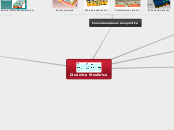Estructuras cerebrales y Sistema Nervioso
A microorganism is an organism so small that people cannot see them with the naked eye.
Microorganisms can be harmful and useful organisms.
Sistema Nervioso Periférico
Harmful microorganisms include fungi, bacteria, protozoa, etc.
They cause several diseases in human beings, animals, and plants, which can even lead to death.
The harmful microorganisms not only can damage the human body, but also the food we eat.
Está compuesto por una ramificada red de
nervios formados por fibras aferentes (que envían estímulos y señales al
cerebro) y fibras eferentes (que envían señales desde el cerebro al resto de los miembros o a un centro inferior de procesamiento).
What diseases can they cause?
AUTÓNOMO
PARASIMPÁTICO
Lo forman las neuronas que
inervan los órganos, los vasos sanguíneos y las glándulas. Este sistema es básicamente eferente, pues transmite impulsos nerviosos desde el sistema nervioso central al periférico y controla actividades que no podemos dominar de forma voluntaria.
SIMPÁTICO
SOMATICO
Responde al ambiente y relaciona el organismo con él; abarca
todos los nervios espinales que inervan la piel, las articulaciones y los músculos que se controlan de forma voluntaria.
NERVIOS
RAQUIDEOS
ESPINALES
Sistema Nervioso Central
Es una estructura muy compleja que procesa
millones de estímulos por segundo, adaptando las respuestas del cuerpo tanto a las condiciones externas como internas.
MEDULA ESPINAL
ENCEFALO
TRONCO ENCEFALICO
BULBO RAQUIDEO
PROTUBERANCIA
MESENCEFALO
CEREBELO
CEREBRO
El sistema Nervioso se divide en 2; Sistema Nervioso central y Sistema Nervioso Periférico
Research about the main characteristics of the microorganisms and give examples!
A nivel funcional, la corteza incluye áreas motrices, somestésicas (sensibilidad
corporal, como la que procede de la piel y los músculos), del lenguaje, sensoriales
(visual, olfativa, auditiva y gustativa)
En la corteza el cerebro procesa la información que le llega de los
sentidos (vista, oído, olfato, gusto y tacto), controla los movimientos voluntarios y
regula la actividad mental caracterizada por el pensamiento.
El cerebro de divide en 2 hemisferios, Los separa el cuerpo calloso
Microorganisms help in the production of many food items, making medicines, keeping the environment clean, in manufacturing, and in research.
HEMISFERIO DERECHO
Give examples of bacteria used in the pharmaceutical industry.
HEMISFERIO IZQUIERO
Give examples of Microorganisms in food production.
El cerebro se divide en 4 Lóbulos
There are five types of microorganisms. Out of these five, four can be free-living or parasitic.
There is one that can be only parasitic since it always reproduces inside other living things.
After enumerating them, click on the flags below to mark the ones which can be free-living and the ones that cannot.
can be free-living
only parasitic
LÓBULO OCCIPITAL:
SE RELACIONA CON EL SENTIDO DE LA VISTA
LÓBULO TEMPORAL:
SE RELACIONA CON EL SENTIDO DE LA AUDICION
LÓBULO PARIETAL:
SE RELACIONA CON EL SENTIDO DEL TACTO
LÓBULO FRONTAL:
SE RELACIONA CON EL SENTIDO DEL HABLA
Que es el cerebro? El cerebro es una de las estructuras más extraordinarias y complejas que existen
en la naturaleza. el cerebro es el
encargado de recibir los estímulos que llegan tanto del exterior, como del interior.
Name the study of microorganisms.









